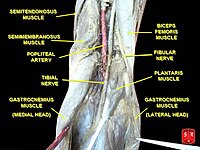
Photo from wikipedia
A 26-year-old male patient was referred for exercise-induced claudication that had interfered with his military duties for the past two years. He was an occasional smoker with no other significant… Click to show full abstract
A 26-year-old male patient was referred for exercise-induced claudication that had interfered with his military duties for the past two years. He was an occasional smoker with no other significant cardiovascular risk factors. Initial Doppler ultrasonography showed narrowing of the popliteal artery. Further evaluation with magnetic resonance angiography demonstrated a short segment occlusion of the popliteal artery secondary to an anomalous origin of the medial head of the gastrocnemius muscle from the lateral femoral condyle. Based on the clinical presentation and imaging findings, he was diagnosed with popliteal artery entrapment syndrome. In this article, we discussed the typical presenting signs and symptoms of popliteal artery entrapment syndrome, the different imaging modalities available to aid diagnosis, classification of the condition and the available treatment options.
Journal Title: Singapore medical journal
Year Published: 2018
Link to full text (if available)
Share on Social Media: Sign Up to like & get
recommendations!